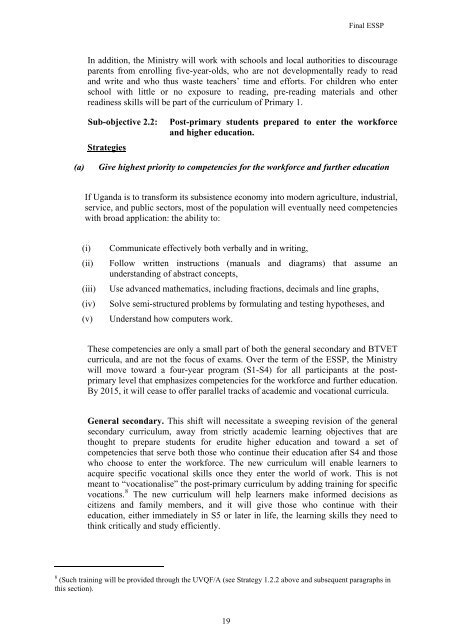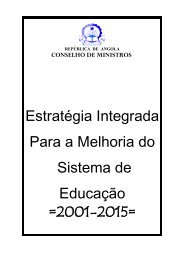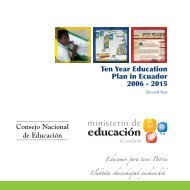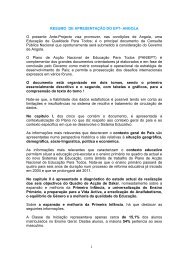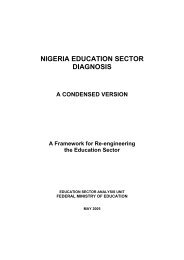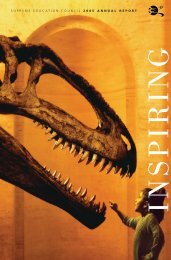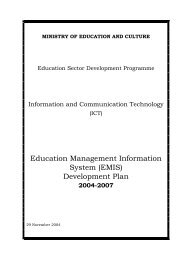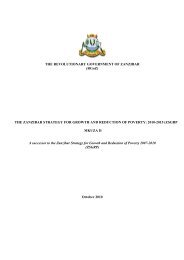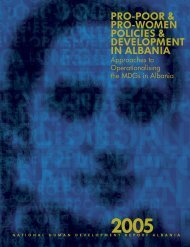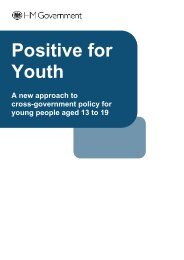Education Sector Strategic Plan 2004-2015 - Planipolis
Education Sector Strategic Plan 2004-2015 - Planipolis
Education Sector Strategic Plan 2004-2015 - Planipolis
Create successful ePaper yourself
Turn your PDF publications into a flip-book with our unique Google optimized e-Paper software.
Final ESSP<br />
In addition, the Ministry will work with schools and local authorities to discourage<br />
parents from enrolling five-year-olds, who are not developmentally ready to read<br />
and write and who thus waste teachers’ time and efforts. For children who enter<br />
school with little or no exposure to reading, pre-reading materials and other<br />
readiness skills will be part of the curriculum of Primary 1.<br />
Sub-objective 2.2: Post-primary students prepared to enter the workforce<br />
and higher education.<br />
Strategies<br />
(a) Give highest priority to competencies for the workforce and further education<br />
If Uganda is to transform its subsistence economy into modern agriculture, industrial,<br />
service, and public sectors, most of the population will eventually need competencies<br />
with broad application: the ability to:<br />
(i) Communicate effectively both verbally and in writing,<br />
(ii) Follow written instructions (manuals and diagrams) that assume an<br />
understanding of abstract concepts,<br />
(iii) Use advanced mathematics, including fractions, decimals and line graphs,<br />
(iv) Solve semi-structured problems by formulating and testing hypotheses, and<br />
(v) Understand how computers work.<br />
These competencies are only a small part of both the general secondary and BTVET<br />
curricula, and are not the focus of exams. Over the term of the ESSP, the Ministry<br />
will move toward a four-year program (S1-S4) for all participants at the postprimary<br />
level that emphasizes competencies for the workforce and further education.<br />
By <strong>2015</strong>, it will cease to offer parallel tracks of academic and vocational curricula.<br />
General secondary. This shift will necessitate a sweeping revision of the general<br />
secondary curriculum, away from strictly academic learning objectives that are<br />
thought to prepare students for erudite higher education and toward a set of<br />
competencies that serve both those who continue their education after S4 and those<br />
who choose to enter the workforce. The new curriculum will enable learners to<br />
acquire specific vocational skills once they enter the world of work. This is not<br />
meant to “vocationalise” the post-primary curriculum by adding training for specific<br />
vocations. 8 The new curriculum will help learners make informed decisions as<br />
citizens and family members, and it will give those who continue with their<br />
education, either immediately in S5 or later in life, the learning skills they need to<br />
think critically and study efficiently.<br />
8<br />
(Such training will be provided through the UVQF/A (see Strategy 1.2.2 above and subsequent paragraphs in<br />
this section).<br />
19


